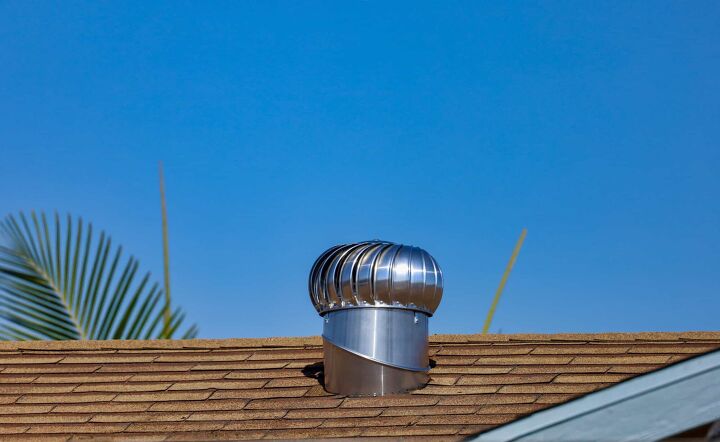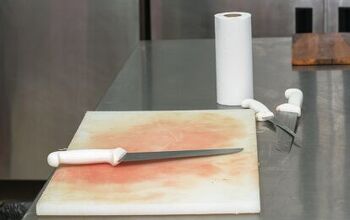How Do You Stop A Turbine Vent From Squeaking?

A squeaky turbine vent can be terribly annoying. Especially if they are the kind that you cannot just turn off with a switch. And they are hard to reach so it is not like you can just spray them with lube easily. But you can fix it if you are able to get up on the roof to get to it.
The cause of a squeaky roof turbine is typically from the lubricant drying out. This causes the metal parts to rub together and make a squeaking noise. So, you have to lubricate the parts to get it to stop the squeaking.
Do You Need Roofing, Siding, or Gutter Installers?
Get free, zero-commitment quotes from pro contractors near you.

You Don’t Have to Climb on the Roof
The problem is, the turbine vent is on the roof, making it hard to get to. For those who are afraid of heights or are just not up to the task of climbing on the roof, you can probably get to it from your attic. If not, you can always pay someone else to do it.
Shoot it from the Attic
If you do decide to lubricate the turbine from the attic, you may not be able to get to the bearings on top from there. So hopefully the squeaking is coming from the lower one. You can use some silicone lubricant (WD-40), but that may not last as long as you want it to. Try something a bit thicker like lithium grease.
Spray and Stay Lubricant
Actually, WD-40 now has a thicker spray that will last longer. They finally made a lithium gel lubricant that will stay where you spray it rather than running back down onto the ground where it will not do you any good. In fact, it is called WD-40 Spray and Stay Gel Lubricant.
Just Use Both
The best way to do it is to spray it with the silicone lubricant first to loosen up any dirt. Then wipe that off before spraying it with the lithium gel lubricant. The gel will stay on better if you clean the bearing with the silicone lubricant first.
The Many Parts of the Turbine Vent
There are several parts to a roof turbine vent. Any time you have more than one part that moves, both lubricants are needed. In a whirlybird roof vent, there is a large shaft in the center that goes from the top to the bottom of the vent.
This shaft is the axis that the fins spin around, but it is the turbine underneath that pulls the air from your attic. But the parts have to be able to spin without moving the fins to vent the air properly. It is the bearings that keep the fins and the turbine from rubbing or getting stuck.
Ball Bearings Help Keep Things Flowing
The bearings are just rings separated by balls that need to be lubricated to work correctly. The inside ring is connected to one part of the vent while the outside ring is connected to the other. These two rings that rotate independently do so with the ball bearings that help keep the spinning smooth.
After a while, the lubricant can wear out or get washed away from rain or moisture. Hot air can also dry them out. If the lubricant dries out, the ball bearings do not move as they should, making them rub together when they spin. That is what is causing your turbine vent to squeak.
Spraying it from the Attic
To fix your squeaky turbine vent without getting on the roof, head up to the attic with those cans of lubricant and a cloth. There should be a mesh guard to keep out dirt and pests. Just remove that mesh and poke the nozzle of the lubricant up into the bearing and give it a couple of good squirts.
Wait until it is not spinning for the best results. The cloth is to wipe off the silicone lubricant. Then you need to spray it with lithium gel lubricant. That will stay on better than the silicone spray.
Fixing the Squeak from the Roof
Although it is not recommended that you get up on your roof unless you are experienced at it, you may have to in order to get to the top bearings. If you do, make sure you wear rubber-soled shoes to keep from slipping and do not go up there if it is windy. Also, be sure to use the proper ladder procedure.
Step One: Find the Squeaky One
After you figure out which turbine vent is squeaking, put a small stick or dowel between the vents to keep it from spinning while you are fixing it.
Step Two: Spray the Top Bearings with Silicone Lubricant First
Find the bearings on the top and wipe away any dirt or dust. Spray it thoroughly with silicone lubricant. Wait a few minutes and then wipe off the excess.
Step Three: Spray it with Lithium Gel Lubricant
Once you clean away any corrosion and moisture with the silicone lubricant, spray it well with the lithium gel lubricant. The gel will stay on longer than the silicone spray.
Step Four: Spray the Inner Bearings
You should be able to see the lower bearings on the turbine with the dowel or stick holding it open. Do the same thing with the silicone and then the lithium gel lubricants. Be careful not to put your fingers inside the turbine.
Step Five: Give it a Spin
Remove the dowel and give it a good spin to distribute the lubricants evenly over the ball bearings.
Quick Tip: You may as well do the other turbines while you are up there as well. It is only a matter of time before they start squeaking too.
Do You Need Roofing, Siding, or Gutter Installers?
Get free, zero-commitment quotes from pro contractors near you.

Related Questions
What Are Some Other Causes of Turbine Vent Squeaks?
Another thing that may cause your turbine vent to squeak is some kind of debris getting stuck in the fins. The only way to fix this is to get up on the roof and get that debris out of there.Another cause of a squeaking turbine vent is if the bearings have come loose. If you see the turbine wobbling or shaking, this could be a loose nut or bearings. Check the inside first, since it is easier to get to.Just tighten up the nut or bearing that is holding the turbine together. Hopefully, that will fix the problem. If not, check the screws or bolts holding the turbine to the roof. They may just need some tightening.
Should I Cover the Vents During the Winter?
It is important to keep the warm air from being sucked out through the turbine vents during cold weather. Cover the vent from the inside with plastic sheeting.You should also be sure to remove any built-up snow from the vent after a heavy snowstorm. The snow can cause pressure on the vent and can also make the blades rust.
Can I Change the Vents to Plastic?
Because turbine vents are continuously exposed to rain and moisture, they tend to rust after a while. You can use plastic instead, but some plastics can get brittle and crack from the cold. Aluminum is actually the best choice since it does not rust and will not become brittle and crack.

I am a DIYer who loves writing about anything home-related. When I am not writing, you can find me studying for my PhD in Psychology, photographing nature, and swimming at the lake with my grandkids.
More by Patricia Oelze














![10 Best Scroll Saws for 2022 [Ultimate Reviews & Buyer's Guide]](https://cdn-fastly.upgradedhome.com/media/2023/07/31/9070684/10-best-scroll-saws-for-2022-ultimate-reviews-buyer-s-guide.jpg?size=350x220)












